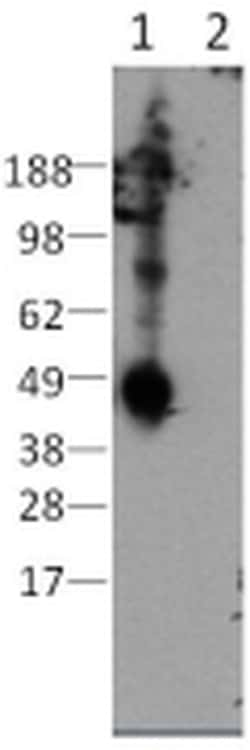Learn More
Invitrogen™ CD207 (Langerin) Monoclonal Antibody (eBioL31), eBioscience™
Rat Monoclonal Antibody
Supplier: Invitrogen™ 14207582

Description
Description: The eBioL31 monoclonal antibody reacts with mouse CD207, also known as Langerin, which is expressed in a distinct subset of dendritic cells called Langerhans cells (LC). mouse CD207 is a 48 kDa C-type lectin transmembrane protein that likely plays a role in antigen recognition and uptake. LC are located in the epidermis and upon activation, reduce CD207 expression and begin migrating through the dermis towards lymphatic vessels. Expression of mouse CD207 in LC has been correlated to the presence of Birbeck Granules. Furthermore, the formation of Birbeck Granules has been observed upon transfection of CD207 cDNA into fibroblast cell lines. Western Blotting with eBioL31 reveals a 48kDa band in lysate from mouse ear epidermis, as well as in lysates from cells transfected with mouse CD207 cDNA. Preliminary data from mouse CD207 cDNA transfected cells suggests that eBioL31 can be used for intracellular flow cytometric analysis in combination with the Foxp3/Transcription Factor Staining Bufer Set (Product # 00-5523). The epitope recognized by eBioL31 is in the extracellular domain within the CRD (carbohydrate recognition domain) and therefore can be used to detect both surface and intracellular langerin. Differences in expression has been observed between mouse strains. Applications Reported: This eBioL31 antibody has been reported for use in flow cytometric analysis, intracellular staining followed by flow cytometric analysis, immunoprecipitation, immunoblotting (W...
Langerin (CD207) is a type II membrane-associated C-type lectin known to be expressed exclusively by Langerhans cells. Lamgerin recognizes mannose residues via its single carbohydrate recognition domain (CRD). Langerin is localized not only on the cell surface, but also intracellularly in close association with Birbeck granules. Transfection of Langerin cDNA into fibroblasts creates a compact network of membrane structures with typical features of Birbeck granules (BG). Langerin is thus a potent inducer of membrane superimposition and zippering leading to BG formation.
Specifications
| CD207 (Langerin) | |
| Monoclonal | |
| 0.5 mg/mL | |
| PBS with 0.09% sodium azide; pH 7.2 | |
| Q8VBX4 | |
| CD207 | |
| Affinity Chromatography | |
| RUO | |
| 246278 | |
| 4°C | |
| Liquid |
| Flow Cytometry, Immunohistochemistry (Frozen), Immunoprecipitation, Western Blot | |
| eBioL31 | |
| Unconjugated | |
| CD207 | |
| CD 207 antigen; CD207; CD207 antigen; CD207 antigen, langerin; CD207 molecule; CD207 molecule, langerin; CLEC4K; C-type lectin domain family 4 member K; C-type lectin domain family 4, member K; Langerhans cell specific c-type lectin; langerin; RGD1565913 | |
| Rat | |
| 100 μg | |
| Primary | |
| Mouse | |
| Antibody | |
| IgG2a |
Safety and Handling
The Fisher Scientific Encompass Program offers items which are not part of our distribution portfolio. These products typically do not have pictures or detailed descriptions. However, we are committed to improving your shopping experience. Please use the form below to provide feedback related to the content on this product.
